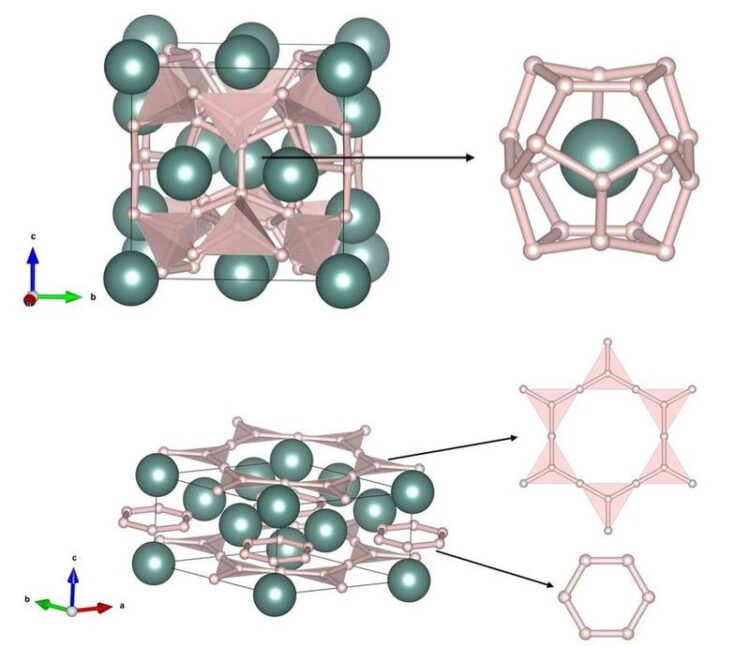New yttrium-hydrogen compounds discovered

The crystal structures of two yttrium hydrides with the chemical formulas Y4H23 (top) and Y3H11 (bottom). Yttrium atoms are green; interconnected hydrogen atoms are light pink.
(c) University of Bayreuth
Researchers at the University of Bayreuth have made a significant scientific breakthrough by discovering new yttrium-hydrogen compounds having serious implications for the research on high-pressure superconductivity. High-pressure superconductivity refers to the property of materials to become superconducting, which means conducting electrical current without resistance, when exposed to certain pressure conditions. The comprehensive high-pressure study of the Bayreuth Researchers shedding light on the complex nature of yttrium hydrides under extreme conditions was published in “Science Advances” journal.
Several rare-earth superhydrides are known for being reported to be near-room-temperature superconductors at high pressures. Superconducting materials allow current to flow without any resistance. In most cases they are products of chemical reactions realized in diamond anvil cells at extreme pressures and temperatures. Their phase and chemical compositions are often unknown, making claims of superconductivity not quite justified, as the measurable critical temperature TC (the temperature below which the material’ electrical resistivity drops to zero) depends on many factors, including the phase purity of the sample and hydrogen content in hydrides. Therefore, the existence of near-room temperature high-pressure superconductors is still under scrutiny.
The use of the modern method of so-called synchrotron single-crystal X-ray diffraction from multiphase microcrystalline samples, developed in the group of Prof. Natalia Dubrovinskaia and Prof. Leonid Dubrovinsky at the University of Bayreuth, enabled unravelling the chemical complexity and richness of the yttrium-hydrogen system under high-pressure high-temperature conditions. At pressures up to about 170 GPa, PhD student Alena Aslandukova and co-authors identified five novel yttrium hydrides with unique structures. These compounds were synthesized in diamond anvil cells through the laser heating of Y-H samples (yttrium with hydrogen-rich ammonia borane or paraffin oil) up to 3500 K.
Single-crystal X-ray diffraction provides valuable insight into the arrangement of yttrium atoms in the crystal structures of these newly discovered phases. Hydrogen content was estimated using empirical relations and ab initio calculations that revealed the specific composition for each compound pointing towards the richness of the Y-H system and diversity of yttrium hydrides under high-pressure conditions.
“The study emphasises the complexity of the yttrium-hydrogen system and its multiphase character at high pressure,” explains Alena Aslandukova. “The results make a significant contribution to our understanding of materials behaviour at extreme conditions and the nature of potentially superconducting hydrides.”
Wissenschaftliche Ansprechpartner:
Prof. Dr. Natalia Dubrovinskaia
Prof. Dr. Dr. h.c. Natalia Dubrovinskaia
Laboratory for Crystallography
University of Bayreuth
Phone: +49 (0)921 / 55-3880 or -3881
E-mail: Natalia.Dubrovinskaia@uni-bayreuth.de
Originalpublikation:
Aslandukova A. Aslandukov A., Laniel D., Yin Y., Akbar F. I., Bykov M., Fedotenko T., Glazyrin K., Pakhomova A., Garbarino G., Bright E. L., Wright J., Hanfland M., Chariton S., Prakapenka V., Dubrovinskaia N., and Dubrovinsky L., Diverse high-pressure chemistry in Y–NH3BH3 and Y–paraffin oil systems, 2024, Science Advances, DOI: 10.1126/sciadv.adl5416
Media Contact
All latest news from the category: Earth Sciences
Earth Sciences (also referred to as Geosciences), which deals with basic issues surrounding our planet, plays a vital role in the area of energy and raw materials supply.
Earth Sciences comprises subjects such as geology, geography, geological informatics, paleontology, mineralogy, petrography, crystallography, geophysics, geodesy, glaciology, cartography, photogrammetry, meteorology and seismology, early-warning systems, earthquake research and polar research.
Newest articles

A universal framework for spatial biology
SpatialData is a freely accessible tool to unify and integrate data from different omics technologies accounting for spatial information, which can provide holistic insights into health and disease. Biological processes…

How complex biological processes arise
A $20 million grant from the U.S. National Science Foundation (NSF) will support the establishment and operation of the National Synthesis Center for Emergence in the Molecular and Cellular Sciences (NCEMS) at…

Airborne single-photon lidar system achieves high-resolution 3D imaging
Compact, low-power system opens doors for photon-efficient drone and satellite-based environmental monitoring and mapping. Researchers have developed a compact and lightweight single-photon airborne lidar system that can acquire high-resolution 3D…





















